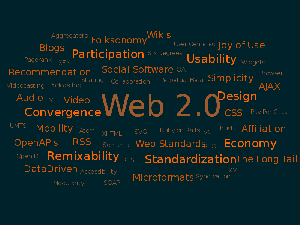Web 2.0
From Computing and Software Wiki
m (→Technical characteristics) |
m (→Technical characteristics) |
||
| Line 12: | Line 12: | ||
== Technical characteristics == | == Technical characteristics == | ||
| - | + | - Tagging : It offers the possibility to users to mark some information and to share it with other people. | |
| - | + | - Publication : Users should tag, edit pages and add some comments. | |
| - | + | - Database : Tagging and published information are centralized in a database accessible for everybody. | |
| - | + | - HTTP : The web communication is based on that protocol | |
| - | + | - XHTML : To display the content of web pages in a structured way. | |
| - | + | - CSS 2.0 : To define the style of websites. Thus, it provides the customization of web pages. | |
| - | + | - Javascript : To improve interaction between users and interfaces. | |
| - | + | - XML | |
| - | + | - RSS | |
| - | + | - [[Web Services ]] | |
| - | + | - Using XML on HTTP in asynchronous mode Javascript is called « Ajax ». | |
== Architecture == | == Architecture == | ||
Revision as of 06:14, 5 April 2009
The expression Web 2.0 was offered to represent the new World Wide Web. This evolution concerns the new technologies used as well as the purposes of the different usages. Web 2.0 is generally used to describe interfaces with which Internet users could interact on the content of web pages and with other users. Thus, it makes Web 2.0 interactive and very suitable for web communities. Therefore, based on a powerful community will, many blogs, social-networking sites, video-sharing sites, wikis appeared to be part of the Web 2.0 . These differents kinds of website show very important characteristics of the Web 2.0 which are information sharing and customization.
Contents |
History
"Web 2.0" is the result of a brainstorming session between O'Reilly and MediaLive International more particularly with Dale Dougherty and O'Reilly. They noticed that the web took another dimension and so was evoluding because many new original and exciting applications and websites appeared very fastly. They furthermore agreed on the fact that the companies which had survived this evolution to share certain things or thoughts. Perhaps it was the start of a collective thought through the web and it marked a turning point for the "Web 2.0" concept which was materialized with the birth of the "Web 2.0" Conference in october 2004. They listed several principles during this first conference; one of the first important principles was "The Web as a platform".
Since then the term "Web 2.0" has been clearly used, with several million citations in Google. However "Web 2.0" is still a topic for discussions because many people disagree with the definition of this term. Some people just see it as a meaningless marketing buzzword, and some others are delighted with this new revolution and accept it as a new collective thought and source of knowledge.
Technical characteristics
- Tagging : It offers the possibility to users to mark some information and to share it with other people. - Publication : Users should tag, edit pages and add some comments. - Database : Tagging and published information are centralized in a database accessible for everybody. - HTTP : The web communication is based on that protocol - XHTML : To display the content of web pages in a structured way. - CSS 2.0 : To define the style of websites. Thus, it provides the customization of web pages. - Javascript : To improve interaction between users and interfaces. - XML - RSS - Web Services - Using XML on HTTP in asynchronous mode Javascript is called « Ajax ».
Architecture
Examples of web 2.0 services
Social issues
References
See also
External links
--Nguyea32 18:32, 2 April 2009 (EDT)Anh-Quan

